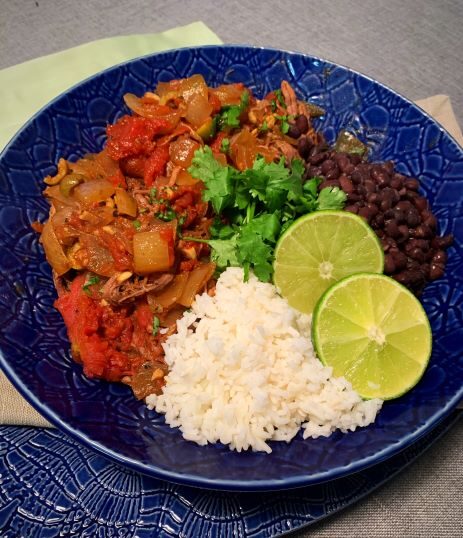Why would anyone want to eat and/or make something that translates into “Old Clothes”? And to that point, why would a country make it it’s National Dish? Well, according to the long standing legend, a poor old man shredded his own clothes and cooked it to feed his hungry family. The man prayed while the clothes simmered long and magically, it was turned into slices of meat and vegetables. The dish was said that the food cured him and his hungry family. And even though the story is too fantastic to believe, the legend showcases that the dish represents a man who supports his family. As many things in the Caribbean and of course, Cuba, the roots of this dish come from Spain. It made it’s way over and has become a staple in several countries other then Cuba including the Dominican Republic, Panama, Puerto Rico and where it was believed to be stolen from, The Canary Islands.

This dish is traditionally simmered “low and slow”, (low temperature for a long time), allowing the flavors to really develop and all the ingredients to become very tender. It’s a filling, surprisingly healthy comfort food that can be served family style or broken up into Cuban Rice bowls. Refrigerating this and eating it the next day will allow even more flavor to build.
There seems to be an urban myth that Chefs don’t like crock pots. Not quite sure why when many of us love low and slow cooking and that’s exactly what a crockpot is all about. I’m here to tell you, I’m a fan. I like many others ate many a crockpot meal growing up and didn’t see the value as a child. I knew I was officially an Adult when I received one for Christmas and was PUMPED. In more recent years, I’ve introduced my better half to the joys of throwing things into a crockpot for easy meal prep through the week. Beings that this is a meal that is traditionally done low and slow, a crockpot version of this seemed like a no brainer.
While the crockpot excelled at having dinner ready for after you came home from a busy day at work, you might be wondering what’s the point when many of us are stuck at home anyways. Well, from what I know, you’d be hard pressed to find many who are at home all the time and don’t have their hands just as full if not more so then when they were out of the house. Home schooling, Zoom meetings, keeping the kids busy and still cleaning is just the tip of the iceberg. So throw all these ingredients in early and let the seductive aroma of this Latin dish get you pumped for dinner.


I used a flank steak for this which is traditional but feel free to use some other cuts of beef such as chuck roast or brisket. The long fibers of the beef is what resembles the “old clothes” look of the dish. Get a good sear on the meat as this will lock the moisture into the beef. Cut all your vegetables to be similar in size so they cook evenly as well. Layer all your ingredients into the crock pot, seal it tightly and let it go! This dish pairs wonderfully with white or yellow rice, some stewed black beans, fresh lime and cilantro leaves.

Ropa Vieja
Serves 6
- 2lb Flank Steak (Brisket or Chuck work too)
- Salt & Pepper for seasoning
- 1 1/2 large Spanish Onion, medium diced
- 1 1/2 Red Pepper, medium diced
- 8 cloves of garlic, minced
- 4 tsp Spanish paprika
- 1 1/2 Tbsp dried Oregano
- 3 tsp Cumin
- 2 tsp ground black pepper
- 2 tsp kosher salt
- 1 tsp Cayenne Pepper
- 1 can of whole peeled tomatoes
- 1/2 cup Spanish Olives with Pimentos, cut crosswise
- 1 tsp white vinegar
Heat a large sauté pan over medium high heat with 1 tsp of canola oil. Dry both sides of flank steak with paper towels and season with salt and pepper liberally on both sides.
Sear both sides of flank steak until they are golden brown and then transfer to 6qt crockpot. Add onions, peppers, garlic, paprika, oregano, cumin, pepper, salt, cayenne pepper, whole peeled tomatoes, olives.
Cook in crockpot on low for 8 hours or on high for 4 hours. Add white vinegar half way through cooking process. Serve hot with white rice, black beans, fresh lime and fresh cilantro leaves.

